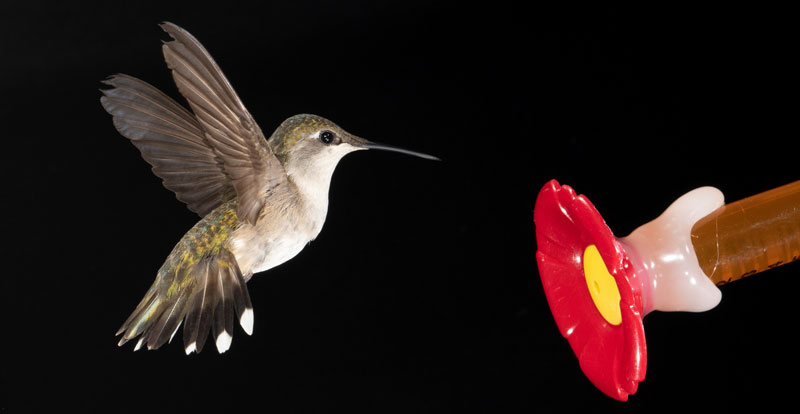Managing the balance between energy supply and demand is a fundamental challenge for all animals. Hummingbirds, some of the smallest warm-blooded animals, are famous for their energetically intense hovering flight and diet almost solely composed of sugary flower nectar. Their high metabolisms must be powered by high rates of energy intake, but most animals cannot effectively rely on dilute sugar solutions (nectar) to power more than a fraction of their activity. Our HFSP-funded research has sought to understand the molecular, physiological, and ecological specializations that enable these diminutive animals to do what they do. Recently, facilitated by the flexibility of HFSP funding, we pivoted to examining not just how hummingbirds accelerate energy intake and usage during the day, but how they manage energy output during the night, when feeding isn’t possible.

Ruby-throated hummingbird (Archilochus colubris). Photo credit: Sherri and Brock Fenton.
During the breeding season, hummingbirds remain lean and agile to perform energetically intense courtship and territorial displays. This means they can’t always afford to bulk up fat stores, made throughout the day from ingested nectar, in anticipation of a long, overnight fast. On nights when energy stores aren’t enough to help them stay warm all night long, they are able to save energy by entering a low-metabolism state called torpor until they can search for food again at first light. During the breeding season, torpor helps hummingbirds survive these occasional nightly “energy-emergencies”. Torpor use is generally avoided unless birds reached a consistently low fat store level (~5% of body mass). Similarly, they use torpor more for nights when they are leaner and have lower fat reserves.
Amazingly, these animals not only face a challenging task balancing energy output and input throughout each day and night, they also undertake a remarkable annual journey from breeding grounds throughout eastern North America, flying south through Texas and New Mexico to wintering grounds in Central America. Then, those birds that have survived must make the return trip north, hurrying to set up the best breeding territories. These journeys take several weeks and are highly demanding in energy. In order to be among the first to precious breeding territories or wintering grounds, most birds fatten up substantially (by ~1/3) prior to making a jump of as much as several hundred kilometers in one or a few continuous flights, before stopping to recover and refuel for the next leg.
Our group found that the fat threshold rule that was followed during the summer breeding period was abandoned in the late summer when birds rapidly fattened up for their long migration flights south. Birds preparing to migrate used torpor more when they were fatter, and they gained more weight when they used torpor for longer. Previous researchers hypothesized that torpor could be used not just to handle low energy store emergencies but also to enhance fuel storage in advance of their energetically expensive journey. Our study was the first to non-invasively measure fat levels in birds, their metabolic rates, and their use of torpor throughout both seasons, allowing us to precisely quantify how their behaviour and their physiology changed as seasonal demands shifted.
Our study demonstrates that torpor is more than just an emergency survival response - animals can use torpor adaptively to meet many different energetic challenges throughout the year. Moreover, this study highlights the underappreciated importance of flexible low metabolism states, like torpor and fasting periods, for how these fascinating animals live life at energetic extremes. Moreover, our study emphasizes the importance this overlooked energetic strategy to the migratory ecology of these and other small, warm-blooded animals.
|
HFSP award information Research Grant - Program (RGP0062/2016): Optimization of metabolic flux in the hummingbird: from enzymes to ecology Principal investigator: Kenneth Welch, University of Toronto Scarborough, Canada |


































